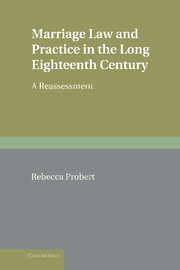Book contents
- Frontmatter
- Contents
- Preface
- 1 Introduction
- 2 The misunderstood contract per verba de praesenti
- 3 The myths of ‘informal’ and ‘common-law’ marriage
- 4 The little-considered marriage practices of non-Anglicans
- 5 The unacknowledged regularity of clandestine marriages
- 6 The eventual passage and actual terms of the 1753 Act
- 7 The unappreciated success of the 1753 Act
- 8 The unexplored judicial interpretation of the 1753 Act
- 9 The overlooked response of non-Anglicans
- 10 Conclusion
- Index
- References
7 - The unappreciated success of the 1753 Act
Published online by Cambridge University Press: 10 February 2010
- Frontmatter
- Contents
- Preface
- 1 Introduction
- 2 The misunderstood contract per verba de praesenti
- 3 The myths of ‘informal’ and ‘common-law’ marriage
- 4 The little-considered marriage practices of non-Anglicans
- 5 The unacknowledged regularity of clandestine marriages
- 6 The eventual passage and actual terms of the 1753 Act
- 7 The unappreciated success of the 1753 Act
- 8 The unexplored judicial interpretation of the 1753 Act
- 9 The overlooked response of non-Anglicans
- 10 Conclusion
- Index
- References
Summary
It has been contended by many scholars that the Act was a failure, and that a significant proportion of couples continued to marry according to their own rites – religious or regional – or simply lived together outside marriage. One commentator has gone so far as to suggest that cohabitation actually increased in the wake of the Act: ‘as the law became stricter, the resort to common-law [sic] rites became more frequent’. Others have suggested that while the 1753 Act was intended to replace custom with law, in practice its operation saw the triumph of custom over law. But we must carefully consider the evidential basis for such claims.
The work of Griffiths, Fox, and Hindle provides a useful starting-point for thinking about attitudes to, and compliance with, the 1753 Act. In considering the broader issue of experiences of authority in the early modern period, they note that the spectrum of interpretative positions included ‘conformity, resignation, passivity, creativity, mockery and opposition’. This encapsulates how individuals may comply with rules willingly, reluctantly, indifferently, or indeed not at all. The vast majority of the population – today as in the past – generally accepts new laws with neither wild enthusiasm nor execration. Even those who actively oppose new laws may recognise that they have no choice but to comply with them once they have been enacted.
This chapter, then, examines five different ways in which the populace might have reacted to the 1753 Act.
- Type
- Chapter
- Information
- Marriage Law and Practice in the Long Eighteenth CenturyA Reassessment, pp. 244 - 283Publisher: Cambridge University PressPrint publication year: 2009



